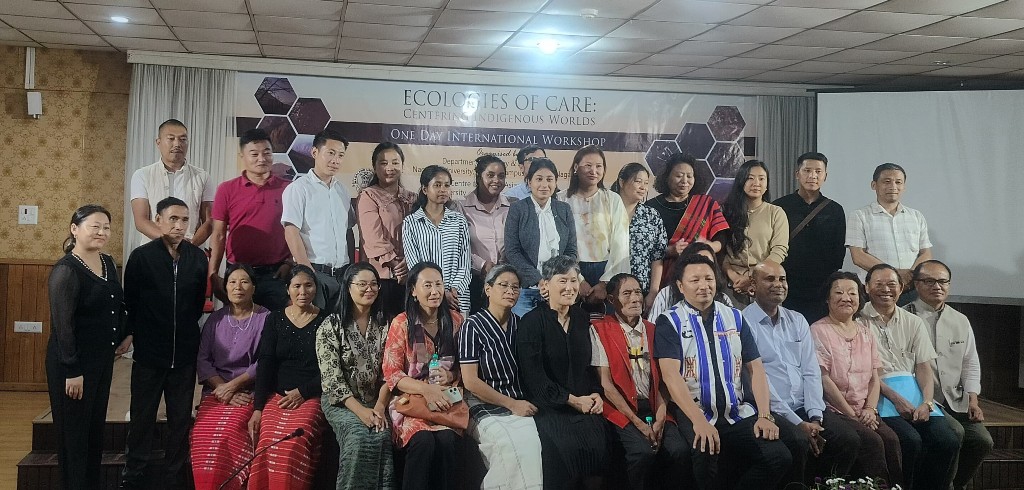Nagaland University and University of California, Santa Cruz, jointly organise workshop on ‘Ecologies of care’ in Kohima on August 18.
Share

DIMAPUR — Nagaland University (NU) and University of California, Santa Cruz (UCSC) have jointly organised a workshop on ‘Ecologies of care’ in Kohima on August 18.
Speaking at the inaugural programme, the chief guest and vice chancellor of Nagaland University, Prof. Jagadish K Patnaik, lauded the History and Archaeology departments for making huge strides in research and collaboration by foregrounding Naga cultural heritage and indigenous epistemologies.
Also read: Sangtam Students’ Union Dimapur denounces act of bully among students
An update from the university stated that Prof. Dolly Kikon, director of Centre for South Asian Studies at UCSC, introduced the initiative as a collaborative dialogue to explore the Himalayan region’s various intersections, expressions and care practices.
By centering indigenous philosophies and care, Prof. Kikon invited participants to not only love one another but also love the lands like their ancestors did. Pointing to the river Chathe, she asked everyone to reflect on how it has shifted from a central part of the Naga world to becoming precarious and dangerous.
While pointing to the dearth of indigenous archaeologists around the world, Prof. Tiatoshi Jamir from the department of History and Archaeology at NU invited students to return to the metaphor of the ‘hearth,’ where indigenous knowledge and wisdom was shared and transmitted in the past.
Drawing from his research, Prof. Jamir explained how returning to folklores on the origins of rice has helped inform archaeology on the early beginnings of crops in northeast India. He stressed the need for reparative research by indigenous scholars that emphasise on ‘with,’ ‘by’ and ‘for’ indigenous communities to decolonise knowledge production in the academia.
It stated that both Prof. Kikon and Prof. Jamir lauded the introduction of new courses on indigenous knowledge now offered at NU and Kohima Science College.
On the occasion, Adela Moa, director of Art and Culture, Government of Nagaland, launched the exhibition titled ‘Naga Lithic Worlds,’ which was curated by Prof. Kikon and Prof. Jamir, showcasing the stone artefacts from the Naga homeland currently held at the Pitt Rivers Museum in Oxford University.
It stated that village elders from Hutsu village namely Kenienuo and Thalü, took the audience through their ancestral practice of brine-making, while Tenosenuo Angami shared the indigenous procedure of salt production as practiced in Matikhru village.
Prof. Pangersenla Walling, theoretical linguist, showed how indigenous languages carry their worldview, which is deeply informed by the surroundings they are spoken, while Dr. Limasanen Longkumer, walked the participants through the myths associated with Jangjanglong from a geological and geomorphological perspective.
Myingthunglo Murry, who teaches at Mount Tiyi College and a PhD scholar at NU, presented on Oha, the luck stones of the Lotha Nagas that were often placed at the village’s mengkitong.
“Some large ones were placed in the Morung and smaller ones were kept at home to bring luck and good health,” Murry said.
Dr. R Chumbeno Ngullie pointed how pottery among the Nagas was never viewed as a trade of low status.
During the workshop, academics shared panels with indigenous knowledge-keepers and practitioners from villages across the Naga homelands. It stated that the audience was re-informed on Naga practices of storytelling, burial practices, songs, languages, fetish stones, luck stones, salt production, architecture, pottery as well as geological distinctness and metallurgical heritage during the discussion.
Meanwhile, the organisers expressed hope that the richness and knowledge shared by indigenous researchers and community elders would provide the requisite inspiration and motivation for young researchers to centre their indigeneity in their research and document the intergenerational wisdom of the Naga people.